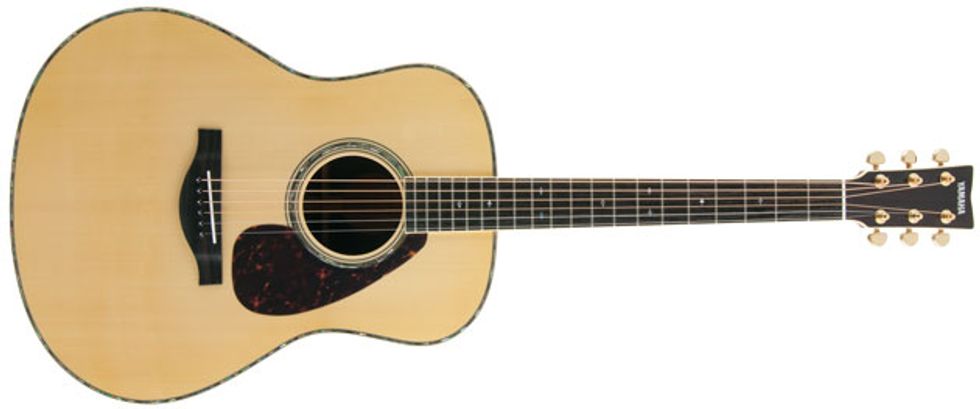Certain guitarists speak in reverent tones about “old wood”—tonewoods aged to perfection after decades of drying and vibrating. Until recently, the only way to get that old wood was to shell out for a vintage instrument. But recently guitar makers have been using temperature and humidity treatments to fast-track instruments to optimal performance.
Processes like these (torrefaction is one such process) were used by the Vikings as early as the 8th century in boatbuilding. In guitar building, crafty use of temperature and humidity can improve the stability and sound transmission of tops to help them take on the darkened hues typical of old guitars—no small consideration to the aesthetically fixated.
High-end guitars are the most frequent beneficiaries of processes like torrefaction, but Yamaha now uses temperature and humidity treatments on some mid-priced guitars. They’ve administered this process, which they call A.R.E. (Acoustic Resonance Enhancement), to violin-family instruments since the late 1990s, and now offer it on Chinese-built guitars like the new LL16D ARE.
Solid Build and Handsome Looks
The solid-wood LL16D ARE is built on Yamaha’s LL platform, a variation on the classic dreadnought body that’s designed to be less boomy. Its A.R.E.-treated Engelmann spruce top is finely and evenly grained, with the warm amber glow of a vintage guitar. The beautiful coloring of the rosewood back and sides ranges from deep purple to warm brown. The top sports abalone on the tasteful purfling and rosette. Plain maple appears on the body binding, heel cap, back strip, and end strip, lending a refined, boutique-like appearance. Gold-plated tuners complete the package. The guitar looks equally sharp in natural finish, as reviewed, or in the optional black.
The LL16D ARE is very well built. The fretwork is impeccable. The nut and saddle are cleanly cut. The body’s high-luster gloss finish is flawless, and the neck’s satin finish is smooth and inviting. Inside, all bracing and kerfing is smoothly sanded.
Ratings
Pros:
A well-built solid-wood dreadnought with a torrefied soundboard. Excellent, balanced tones. Good-sounding electronics.
Cons:
Not as much bottom end as some dreadnoughts.
Tones:
Playability:
Build:
Value:
Street:
$999
Yamaha Guitars
yamaha.com
Lightweight and Loud
The light, evenly balanced LL16D ARE is comfortable to play. While a traditional bluegrass player might find the factory-set action a bit low, players who double on the electric will appreciate this setup. Despite the low action, notes ring true and clear at every fret.
The guitar boasts Yamaha’s newest neck profile design. The nut is 1 3/4, a selling point for fingerstyle players. The neck feels both hefty and sleek. It’s easy to play for long periods without fret-hand fatigue, even when using many barre chords. And the neck’s stiff, five-ply design means it will be more stable over time than a one-piece, at least theoretically.
Subjected to open cowboy chords, the LL16D ARE reveals itself as fairly loud, bright, and responsive. While it may lack the powerful bottom end of the best dreadnoughts, it has good tonal balance and strong projection and sustain. It feels alive and responsive. There’s plenty of clarity, too—it’s easy to hear the individual notes of each chord, even on tightly voiced harmonies high on the neck.
Fingerpicked, the LL16D ARE may not sound quite as sweet as the finest OM or parlor guitars. But it’s touch-sensitive, and it requires little effort to extract beautifully ringing arpeggios. The guitar sounds equally robust in standard, open-G, and DADGAD tunings. It also responds well to flatpicked single-note lines. Whether I played bluegrass licks, Django runs, or straightforward blues lines, the instrument displayed strong presence and definition, even on the top two strings, where many guitars sound anemic.
Unobtrusive Electronics
The LL16D ARE includes Yamaha’s SRT Zero Impact pickup, a passive under-saddle system with separate piezo elements for each string. I’m glad Yamaha omitted the unattractive plastic preamp that compromises the design integrity of so many acoustic-electric guitars.
Plugged into a Fender Acoustasonic amp, the pickup sounds excellent, capturing the guitar’s natural acoustic sound in faithful detail without tubbiness or feedback. (Some players may miss having onboard preamp controls, but there are many good, inexpensive external alternatives, such as LR Baggs’s Gigpro.)
The Verdict
The LL16D ARE is an excellent update to Yamaha’s 40-year-old L line. The guitar’s solid woods and top-notch construction definitely inspire confidence. While it’s difficult to test the manufacturer’s claims that A.R.E.-treated wood behaves as if it’s been on an instrument for generations, the torrefied Engelmann spruce soundboard has a resonant tap tone and a rich voice when strummed or fingerpicked—a voice that amplifies well, thanks to the proprietary under-saddle pickup. At about a grand street, the LL16D isn’t cheap for a Chinese-made guitar, but sonically, it stacks up favorably against its more expensive counterparts.














![Rig Rundown: Russian Circles’ Mike Sullivan [2025]](https://www.premierguitar.com/media-library/youtube.jpg?id=62303631&width=1245&height=700&quality=70&coordinates=0%2C0%2C0%2C0)








